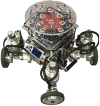ODAS: Open embeddeD Audition System
- PMID: 35634264
- PMCID: PMC9131248
- DOI: 10.3389/frobt.2022.854444
ODAS: Open embeddeD Audition System
Abstract
Artificial audition aims at providing hearing capabilities to machines, computers and robots. Existing frameworks in robot audition offer interesting sound source localization, tracking and separation performance, although involve a significant amount of computations that limit their use on robots with embedded computing capabilities. This paper presents ODAS, the Open embeddeD Audition System framework, which includes strategies to reduce the computational load and perform robot audition tasks on low-cost embedded computing systems. It presents key features of ODAS, along with cases illustrating its uses in different robots and artificial audition applications.
Keywords: embedded computing; microphone array; open source framework; robot audition; sound source localization.
Copyright © 2022 Grondin, Létourneau, Godin, Lauzon, Vincent, Michaud, Faucher and Michaud.
Conflict of interest statement
The authors declare that the research was conducted in the absence of any commercial or financial relationships that could be construed as a potential conflict of interest.
Figures










References
-
- Brière S., Valin J.-M., Michaud F., Létourneau D. (2008). “Embedded Auditory System for Small Mobile Robots,” in Proceedings of the IEEE International Conference on Robotics and Automation, Pasadena, CA, May 19–23, 2008, 3463–3468. 10.1109/robot.2008.4543740 - DOI
-
- Chakrabarty S., Habets E. A. P. (2019). Multi-Speaker DOA Estimation Using Deep Convolutional Networks Trained with Noise Signals. IEEE J. Sel. Top. Signal Process. 13, 8–21. 10.1109/jstsp.2019.2901664 - DOI
-
- Cohen I., Berdugo B. (2002). Noise Estimation by Minima Controlled Recursive Averaging for Robust Speech Enhancement. IEEE Signal Process. Lett. 9, 12–15. 10.1109/97.988717 - DOI
-
- Côté C., Létourneau D., Michaud F., Valin J.-M., Brosseau Y., Raievsky C., et al. (2004). “Code Reusability Tools for Programming Mobile Robots,” in Proceedings of the IEEE/RSJ International Conference on Intelligent Robots and Systems, Sendai, Japan, September 28–October 2, 2004, 1820–1825.
-
- Culjak I., Abram D., Pribanic T., Dzapo H., Cifrek M. (2012). “A Brief Introduction to OpenCV,” in Proceedings of the International Convention on Information, Communication and Electronic Technology, Opatija, Croatia, May 21–25, 2012, 1725–1730.
LinkOut - more resources
Full Text Sources

